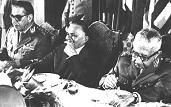

General Dynamics Electric Boat delivered the latest Virginia class submarine to the U.S. Navy, ahead of schedule on December 22, 2006. Hawaii (SSN-776) is the third ship of the Virginia Class, the US Navy's first major class of combatant ships designed for operation in both littorals and the open oceans.
In December 2006 General Dynamics' Electric Boat corp. was awarded $1.274 Billion modification to a multi-year contract supporting for Fiscal Year 2007 construction of Virginia Class Submarine (SSN 782) and Advance Procurement funding for the forthcoming sub, submarine (SSN 783) scheduled for FY08.
The Virginia class submarine has one of the most advanced torpedo delivery systems in the fleet. In addition to torpedoes, the Virginia-class will be armed with Tomahawk cruise missiles and has been designed to host the Advanced SEAL Delivery System (ASDS) and Dry-Deck Shelter to support various missions.

Electric Boat and Northrop Grumman Newport News have received contracts to build the first 10 submarines of a planned 30-ship Virginia Class under a teaming agreement that splits the construction workload between the two shipyards. Three submarines completed construction and are undergoing sea trials - SSN-774 Virginia, SSN-775 Texas and most recently, SSN-776 Hawaii. SSN-777 North Carolina is currently under construction at Newport News.
Kollmorgen Corporation, Electro-Optical Division has been awarded US$17.5 million to exercise an option for the production of nine Integrated Submarine Imaging Systems (ISIS). ISIS provides an all-weather, visual and electronic search capabilities for SSN 688, SSN 21, and SSGN Class submarines.
Digital System Resources, Inc., a subcontractor of General Dynamics Advanced Information Systems was also awarded $6.6 million for the production of three Photonics Mast Workstations (PMW). These workstations will be installed on Virginia Class Submarines. This order follows the original ten PWM systems ordered in 2005. Photonics Mast Workstations are integrated into the Photonics Mast System, a non-hull-penetrating imaging system replacing conventional periscopes in modern submarines. (More on th Photonics Mast: Defenseindustrydaily and Howtuffworks)
fonte: DEFENSE-UPDATE







